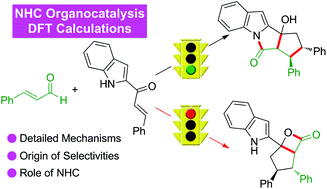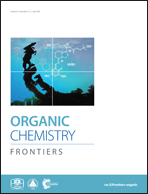Insights into the NHC-catalyzed cascade Michael/aldol/lactamization reaction: mechanism and origin of stereoselectivity†
Abstract
The detailed mechanism and origin of stereoselectivity of the N-heterocyclic carbene (NHC)-catalyzed cascade Michael/aldol/lactamization reaction of enals and indole-derived enones have been investigated in theory. Based on the computational results, the reaction contains seven steps, including the nucleophilic addition of NHC to enal, the intramolecular proton transfer for the formation of a Breslow intermediate, the intermolecular Michael addition reaction of indole-derived α,β-unsaturated ketone with the Breslow intermediate, the subsequent [1,6]-proton transfer to afford the enolate intermediate, the intramolecular aldol reaction coupled with the proton transfer process, the intramolecular lactamization reaction, and the release of NHC catalyst from the product. Moreover, the C–C bond formation step involved in the intermolecular Michael addition reaction was identified to be the stereoselectivity-determining step, and the RS-configured product was generated preferentially. In addition, the NCI analysis indicates that the more effective C–H⋯π and π⋯π interactions contribute significantly to the stability of RS-configured transition state. The mechanistic insights obtained in this study should open the door for the rational design of reactions for the effective construction of functional heterocyclic molecules via a sequential strategy with NHC organocatalysis.



 Please wait while we load your content...
Please wait while we load your content...